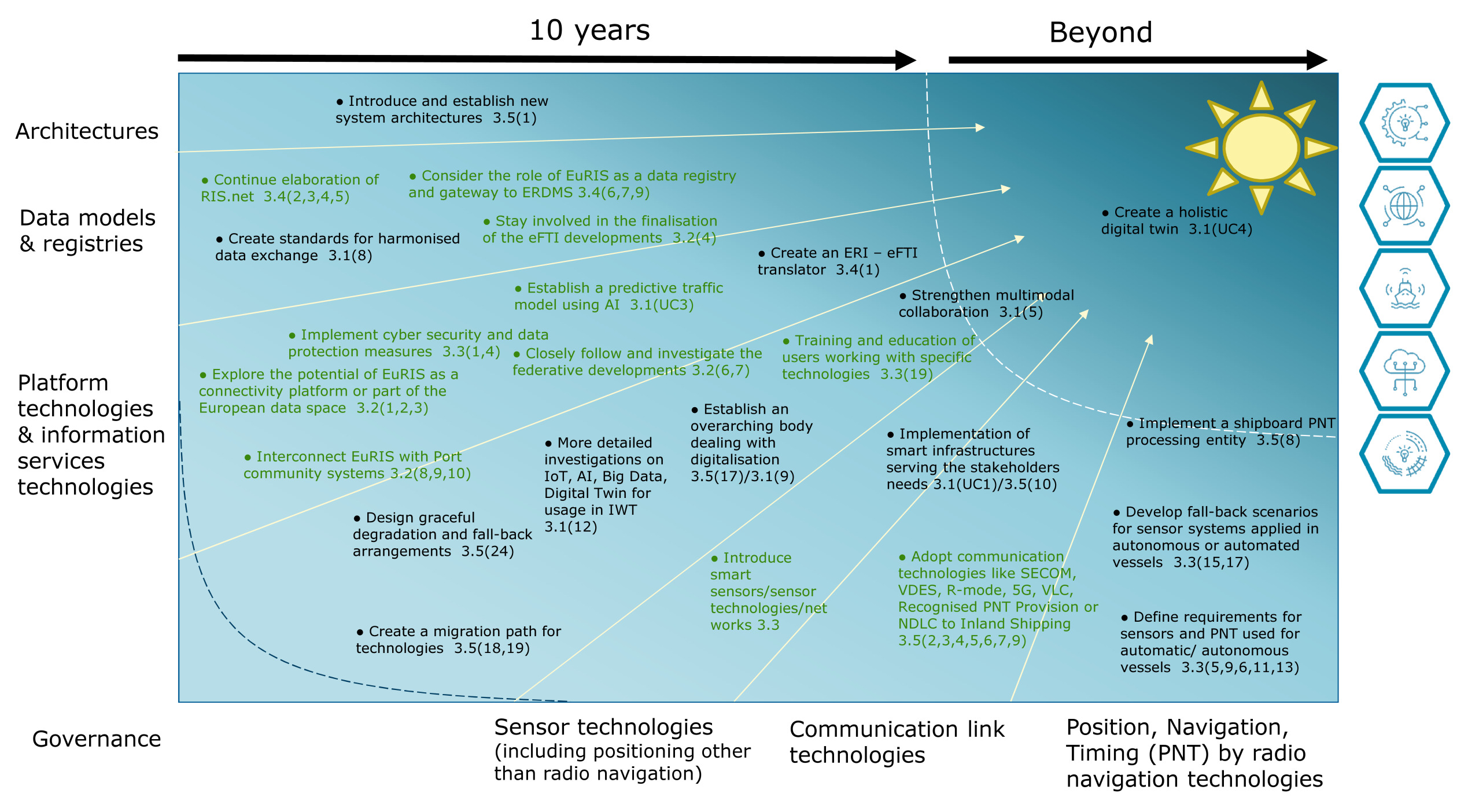The technological developments of the Masterplan DIWA project comprise 5 studies. The 5 studies followed a similar approach by describing the current state of digitalization and the foreseen future state in the next decade(s).
Data exchange via platforms like EuRIS and interconnection with other systems (i.e. Port Community Systems, eFTI compliant applications, etc.) via standardised interfaces will play a key role in developing IWT. Having a harmonised data model (RIS.net) and advanced technologies like AI, Big Data, Cloud Computing implemented will further enhance data management. Gathering high quality data from sensors at vessels or infrastructure will utilise efficient processes and enable higher degrees of automation. This will only succeed with advanced communication links between the involved stakeholders, making connectivity and secure backup communication links a key pillar of digitalisation. But also, the sensor accuracy and reliability on-board of vessels needs to be improved via e.g. PNT systems being the prerequisite for remote control or higher degrees of automation. All this could be advanced within defined architecture models for IWT, always considering the need for good governance throughout all processes and involved players to bring digitalisation forward in a coordinated approach. These key findings depict the basis for the future state of digitalisation being “digital by default” supported by a holistic digital twin representation and synchromodal processes.
The main findings for each study are:
- 3.1 New technologies
- The harmonisation of data sets and interfaces together with the re-use of existing service and data provision solutions will result in advanced data exchange platforms initiating and strengthening the multimodal international collaboration. Smart & competitive infrastructure may be monitored with meaningful KPIs, captured by IoT devices. The use of AI in prediction models is expected to change services from decision support to decision making tools. Interconnecting all digital twins of the different transport modes will form a virtual holistic digital twin of the European transport system. Thus, assets and data streams of digital twins need to be interoperable.
- 3.2 IWT Connectivity platform
- EuRIS as a holistic IWT information platform and important part of the EU data space is expected to evolve to a single-stop-shop for IWT and shall be extended with connectivity platform functionalities. eFTI is further considered as an opportunity towards paperless as well as synchromodal transport and will lower administrative burdens. Projects like FENIX and FEDeRATED provide innovative developments that will be closely followed.
- 3.3 Smart sensoring & Positioning
- Emission related sensors are gaining more importance. Affordability and the correct calibration are identified as future challenges. Fall-back options and cybersecurity will be highly important for the use of smart sensors as well as guidelines for setting up sensors and training of sensor users. High data quality and the indications of accuracy will become increasingly important as crucial decisions will be made upon sensor data.
- 3.4 Data model & Data registry
- RIS-net is expected to become one of the pillars of future RIS application. Furthermore, the use of the Maritime Resource Name in IWT is strongly recommended. EuRIS could further evolve to an ERDMS gateway for the IWT community. eFTI is considered as opportunity for IWT to connect with other transport modes. Divergences between eFTI and ERI should thus be avoided where possible. Developments on ‘decentralised’ architectures as for example proposed by the FENIX project shall be evaluated carefully including their interoperability with established and operational centralised solutions like EuRIS.
- 3.5 Technologies in other transport modes
- Maturity models are gaining ground with IWT Digitalisation Levels (IDL) being considered as a specific example. Functional and technology-oriented architectures are becoming increasingly important across the transport modes and shall be adapted towards IWT use cases. It is recommended to stringently embark on transformation processes towards Nautical Datalink Communications (NDLC) instead of voice wherever safely possible for both Automated Vessels (AV), Remotely Operated Vessels (ROV) and traditionally operated vessels. The ‘S-100 World’ was already introduced in IWT with the creation of an own inland domain in the ‘S-100’ registry and the ongoing development of ‘S-401’. The IWT domain shall investigate whether other inland technologies (e.g. NtS, water level information) should evolve to a S-100 product specification.
The recommendations are plotted in the following figure. The recommendations have been taken up and considered by other activities within the DIWA Master Plan project. In a further step, they will be elaborated in cooperation with the stakeholders. As done in Activity 2, the recommendations were summarised by means of more general terms in order to not “overload” the picture. Where applicable a reference to the sub activity and action point is mentioned. Items in green signify an ongoing effort across the entire timeline.

As illustrated in the figure above, many of the recommended actions regarding technological developments are already have been started and are making progress. The improvements in the various technological areas, in close cooperation with the stakeholders, are intended to lead to a modern waterway system that provides additional and more accurate data, thus increasing safety, making forecasts more reliable and also enabling smart navigation on inland waterways. After the considered time period of 10 years of the DIWA project, all technological implementations shall result in a digital twin of the inland waterways or even a holistic digital twin that takes into account several transport modes. This will enable new and better services for an IWT service catalogue. The recommendations in the roadmap are are categorised by following areas:
- Architecture
- Data model & registries
- Platform technologies & information services technologies
- Governance
- Sensor technologies
- Communication link technologies
- PNT by radio navigation technologies
